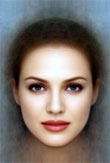New Wrinkle in Search for Youthful Look

Creams and surgeries that promise to wipe away facial wrinkles can't begin to fight a newly realized nemesis. Poor skin tone can add 10 to 12 years to a woman's perceived age.
New research detailed in the journal Evolution and Human Behavior found that faces with more even skin tone were judged by others to be younger while women with blotchier skin tones appeared older.
"This study points out that wrinkles aren't the only visual cue to a woman's age," said Karl Grammer of the Ludwig-Boltzmann-Institute for Urban Ethology at the University of Vienna in Austria.
Scientists led by Grammer took digital photos of 169 Caucasian women between the ages of 10 and 70. Then they used specialized morphing software to "drape" each subject's facial skin over a standardized model, in effect, taking 169 different skin tones and applying them to a common facial canvas.
In the process, they removed other potential age-defining features such as facial furrows, lines and wrinkles. The scientists asked 430 observers to estimate each model's age and to gauge her health and attractiveness.
The observers gave much higher ratings for attractiveness and health to models with the most even skin tone compared with blotchy-skin models. Plus, they judged the smoother-skin models were younger.
Several factors could alter a person's skin tone, including cumulative UV damage that can lead to freckles, moles and age spots, and the number of blood vessels under the skin, which can create red areas. Natural aging can also cause a yellowing and dullness of skin color.
Sign up for the Live Science daily newsletter now
Get the world’s most fascinating discoveries delivered straight to your inbox.
"We found that cumulative UV damage from too much sun dramatically influences skin tone, giving women yet another reason to prevent future UV-related skin damage or try to correct past sun damage," said study co-author Bernhard Fink of the University of Goettingen in Germany.
Next the scientists will partner with a skin-imaging expert to look at the distribution of three molecules found in the skin—hemoglobin, melanin and collagen—responsible for skin tone, which they suggest could directly affect the perception of attractiveness and youth.
- Why Do We Get Freckles?
- You and the Sun: 10 Burning Questions
- Beauty Boils Down to a Simple Average
- Video: Sex & the Senses
- Body Quiz: The Parts List
- Zit Myths Cleared Up
Jeanna Bryner is managing editor of Scientific American. Previously she was editor in chief of Live Science and, prior to that, an editor at Scholastic's Science World magazine. Bryner has an English degree from Salisbury University, a master's degree in biogeochemistry and environmental sciences from the University of Maryland and a graduate science journalism degree from New York University. She has worked as a biologist in Florida, where she monitored wetlands and did field surveys for endangered species, including the gorgeous Florida Scrub Jay. She also received an ocean sciences journalism fellowship from the Woods Hole Oceanographic Institution. She is a firm believer that science is for everyone and that just about everything can be viewed through the lens of science.









